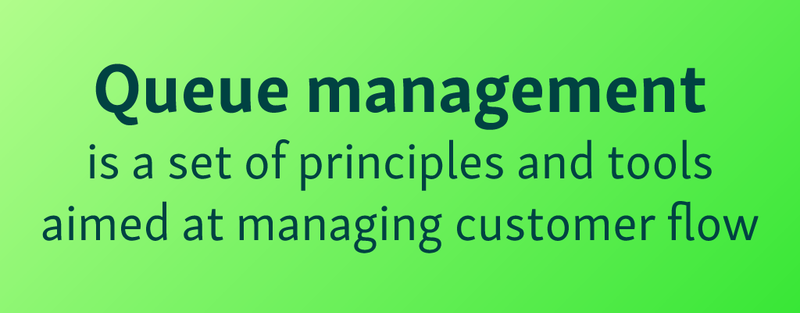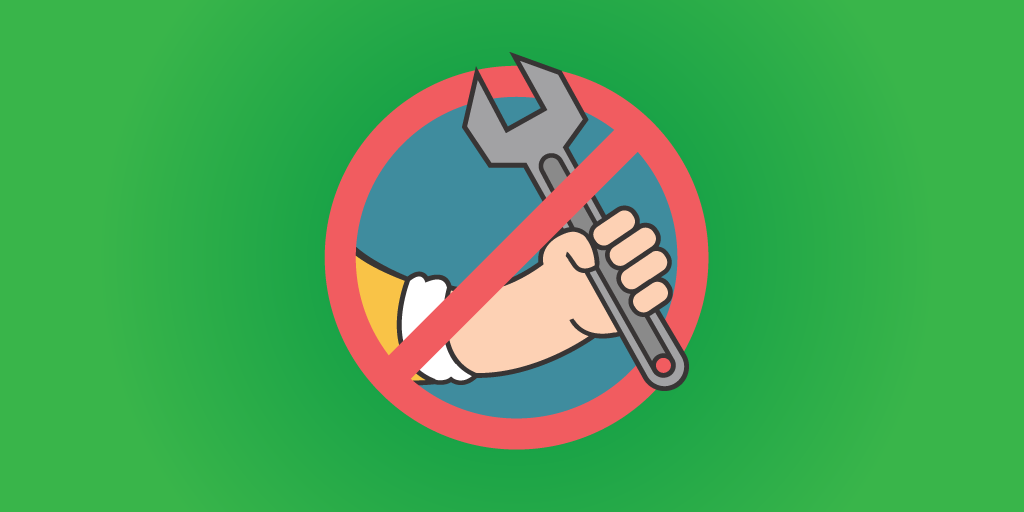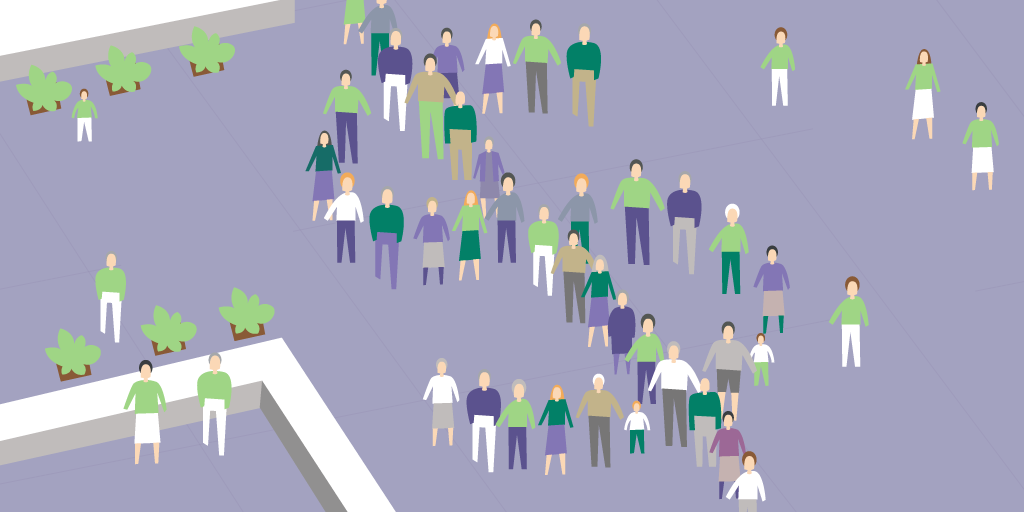Customer experience has become the hot new battleground for the companies to compete in.
The problem? These same companies don’t know from which side to approach customer experience.
If you’ve so much as glanced at the title of this article, you’ve already spoiled yourself on what we propose as the answer — the queue management pyramid.

It may not look like much, and on paper it definitely looks less impressive than those behemothian structures that the Ancient Egyptians slaved over, but please bear with us. We'll show you exactly why the queuing pyramid model is relevant to most businesses.
As you can see, the queue management pyramid has three tiers:
TIER 1: Customer experience
TIER 2: Service intelligence
TIER 3: Queue management
We’re going to go over them one by one, and despite the name of this article, we will be starting from the top.
Feel free to jump to any section, although I encourage you to read from the very beginning to get the full scope of what we’re talking about here.
TIER 1: Customer experience

The grand jewel that sits on top of the queue management pyramid is customer experience, or CX for short.
Throughout the years we’ve dedicated so much attention to customer experience, that we may sound like a broken record. That’s why we’ll try not to bore you with reasons why customer experience is great (you should know that by now).
Suffice to say, a 2014 survey by Gartner found that 89% of U.S. companies expect to compete mostly on the basis of customer experience.
Choosing to focus on CX does not mean that your path to success is automatically cut out for you. You need to prove yourself in a classic case of “My kung fu customer experience is stronger than yours.”
What makes or breaks a company’s customer experience approach is their adherence to what you may call the customer experience trifecta.
The CX trifecta consists of three E’s: empathy, expertise, and ease.

EMPATHY is the ability to identify and sympathize with another person’s situation, beliefs and feelings.
Understanding your customer, especially in a customer-facing setting, is no small goal. You need to rethink the ways in which you engage with customers. You need to understand how your business makes people feel and what they experience every step of the way.
The quality of the service your team provides is intrinsically linked to your business’ image. Genuine and authentic interactions can prove to your visitors that at the center of your company, there beats a human heart.
In his 2011 book Thinking, Fast and Slow, Daniel Kahneman offers this sentiment:
“We are not thinking machines that feel, we are feeling machines that think.”
EXPERTISE is a bit trickier to describe. It can be hard to notice that it’s there until it’s not there.
Knowledgeable employees are expected, not always realistically, to handle everything, from rudimentary questions to advanced troubleshooting. The team should know not only their product but also their customers — what they need, what their pain points are, and what their behavior patterns look like.
It takes time and effort to train employees so that they would get specific details and technical nuances right, but it pays to do so. It today’s highly competitive world, expertise is a big differentiator and can make a lasting impression on both first-time visitors and long-time customers.
Taught from their experience not to accept mediocrity, customers grow more demanding by the day. Incompetence, therefore, is often considered par for the course, so a truly competent interaction delights customers in a surprising fashion.
Finally, EASE is an umbrella term that includes every facet of doing business: from completing transactions to the location of, ahem, location.
As Shep Hyken said, “There is a reason that convenience stores are called convenience stores.” These venues are aimed to give you the fewest problems possible, as they’re always somewhere in the vicinity and offer quick, almost painless service.
More often than not, though, ease and convenience come down to the use of technology. The list of delivery and payment options you need to provide grows ever longer. The role of access, both offline and online, is hard to overstate. Self-service, aka helping your customers help themselves, is not-so-slowly shifting from the “Good to have” category to “An absolute must”.
Even something as universal as queues is being disrupted with technology, as we will see later in the article.
To ignore one aspect of the CX trifecta in favor of two others does no good to you. If you use one or two elements as your sole competitive differentiators, you are setting yourself up for a rude awakening.
Empathy without competence is pleasant but unfulfilling, competence without ease is insightful but distant, and ease without empathy is convenient but leaves you cold.
As Aristotle once said:
“We are what we repeatedly do. Excellence, then, is not an act, but a habit.”
Employee experience: the other side of the coin
Have you ever heard the saying “Charity begins at home”? The same principle could be applied to experience management — it begins with how well employees are treated.
Among companies providing superior customer experience, 70% and 24% have significantly better or moderately better employee experience, respectively. Employee experience quite literally pays off.
How to achieve it, then?
Good company culture is only one part of it. Jacob Morgan offers his own interpretation of what makes up a good employee experience. Namely, the three environments that create every employee experience.
(Yes, again with the number three. Brace yourselves.)
The three environments that Morgan outlines are:
Cultural environment
Physical environment
Technological environment

Cultural environment is an amalgamation of values, attitudes, policies, vision and mission of the company. When people spend tens of hours a week next to each other in one place, the atmosphere and the sense of community become essential.
A healthy company culture takes into account maintains the balance between a hard work ethic, a fun environment, and team spirit. It is what encourages employees to advertise their workplace to other people.
Lack of good cultural environment, on the other hand, can lead to unnecessary stress, strained relationships and, ultimately, high turnover rates.
Physical environment, or the physical workspace, is something tangible, something that we can see, touch, smell, and occasionally taste. It is one of the more obvious incentives to make employees come to the office in the morning, as it helps promote a sense of purpose and connect it to the company’s mission.
Physical space acts as a symbol of your company. Each value that your company promotes for real and not just on paper is manifested physically in your work environment.
Technological environment refers to the complete array of tools that employees use, from an internal communication tool to CRM solutions. Technology has become the central nervous system of most companies, and your workplace experience strategy should reflect that.
Providing a good technological environment means providing all the tools the employees need to succeed and grow. Without technology that lets them better understand their customers and those customers’ needs, your employees are effectively blind.
Companies that do not invest in bettering their technological environment face a tremendous pushback from their staff. Having to use outdated, ineffective tools not only prevents your employees from completing their tasks but also negative affects their sense of self-worth.
Summing up
Customer experience is aimed at improving customer satisfaction and strengthening your relationship with them.
CX has become a major differentiator between competing businesses.
For CX to feel great, it needs to rely on empathy, expertise, and ease.
Employee experience is an integral part of CX, and it positively affects customer satisfaction as well as the outcome of customer interactions.
Additional reading
Want to know more? Here’s a list of articles on customer experience that might interest you:
TIER 2: Service intelligence

One tier below customer experience is service intelligence.
The reason why the term “service intelligence” sounds so close to “business intelligence” is because the underlying principles are the same. In fact, you can open any article about BI and substitute the word “business” with “service”, and get your 101 introduction to service intelligence.
How is service intelligence connected to customer experience?
As we’ve discussed above, great customer experience relies in no small way on your team’s competence and empathizing with your customers. Just like business intelligence is designed to feed you relevant data, service intelligence gives you the answers that let you better understand the customers you serve (their needs, wants, behavior patterns, etc.)
Moreover, service intelligence lets you up your employee experience, by giving your staff the tools they need to complete their task and productively use their time.
It’s time to go into detail.
The benefits of service intelligence
Delivery of useful service information
Service intelligence allows to gain insight into visitor behavior and deepen your customer knowledge so that you could turn this data into actionable information. With SI, you can identify service trends to adapt quickly to a changing environment.
Coupled with CRM solutions, service intelligence helps gain a competitive edge and make successful strategic decisions.
Insight into visitor behavior
A service intelligence solution lets you understand, at a glance, how your visitors behave and what they encounter on their journey.
As even the company’s queuing strategy starts playing a larger role in customer satisfaction (remember: convenience matters), you need to not only know how much time on average your visitors wait in line but also the ways in which you can fix that.
Improved visibility
Have you as a manager ever asked yourself questions like these:
Which employees are the best performers?
Which service desks get the most attention?
Which lines/locations are in need of improvement?
Should I get temporary hires for peak season?
Service intelligence gives a quick but detailed overview of the service situation at your business locations. By accumulating relevant data over a selected period of time, it gives you more than enough information to answer the questions above.
With SI, you can know for sure which of your employees are handling their tasks well, and which require your help.
Increased efficiency
Connected with the previous point, service intelligence powers up productivity by identifying bottlenecks in your service flow. It helps you refine existing service processes and make better use of your team’s time.
This efficiency is also evident at a managerial level and higher, as service intelligence provides automated reports, complete with graphs and visuals. This allows to make better-informed service decisions.
Service intelligence, in pictures
To better illustrate, both figuratively and literally, the capabilities of service intelligence, let’s take a look at how it’s handled by our system — Qminder.
You can check out Qminder's service intelligence yourself, by signing up for a free trial. Before that, we'll give you a free visual sample below.

Queue Length shows the average amount of visitors waiting in line. Waiting times designate how long a visitor needs to wait before being called, and serving times are the length of servicing a single visitor.

Daily Visitors calculates the total number of visitors across different service lines on the basis of this formula: Served Visitors + No Shows + Cancellations = Total Visitors

Average Hourly Visits is similar to Daily Visitors, but it shows hourly visitor traffic, with the X-axis representing hours (with “am”/“pm” designation for context).

Visits by Day of Week shows how visitor traffic changes throughout the working week.

Channels is a chart that breaks down how visitors have chosen to sign in. This can be either manually by a clerk or via an iPad self-sign-in application.
Summing up
Service intelligence gives you an overview of the service trends and overall situation at your business locations.
Service intelligence gathers data about your visitors and your team’s performance serving them.
Service intelligence helps you improve the efficiency of your service strategy and improve the productivity of your employees.
By doing this, service intelligence effectively raises the level of both your customer and employee experience.
Additional reading
Want to know more? Here’s a list of articles on service intelligence that might interest you:
TIER 3: Queue management

The queue management pyramid is supported at the foundation by effective queue management.
Your first question is probably “What does queue management have to do with customer experience?” Don’t worry, we will get to that in a bit.
But first, let’s try to decipher what queue management is and what it is not.
A queue is a line of people awaiting services or products. If you think of queue standers in this context, waiting lines become a textbook example of how demand exceeds supply. As a service provider is unable to meet the needs of every customer simultaneously, people end up having to form queues and wait for their turn.
Which leads us to this: Queue management is a set of principles and tools aimed at managing customer flow.

Now, to the question of why queue management matters. The simplest answer is that there is a symbiotic relationship between all three elements of the queue management pyramid.
(Okay, maybe “symbiotic” is a weird term to use when talking about pyramids. Let me start over.)
Each of the three elements of the queue management pyramid supports the structure above it. Take one element out, and the carefully constructed Jenga tower crumbles under its own weight.
As queue management serves as the foundation of this pyramid, it is an essential part of any service strategy. Think of it like this: queue management feeds into the service intelligence, which strengthens customer experience.

The benefits of queue management
Reduced wait time
This is the more obvious consequence of effective queue management, although it’s not immediately obvious why that’s something you should care about.
To put things into perspective: Americans spend around 37 billion hours per year waiting in line. That’s 113 hours on average per every American, infants and elderly people included. An average New Yorker in particular spends 6 minutes and 51 seconds waiting for their turn in a store.
It’s true that New York, as one of the most traffic-congested cities in the world, does not have a good track record when it comes to time management. Still, its wait times are emblematic of a waiting epidemic that has spread over the entire globe.
Increased customer loyalty
The checkout lines are the most critical junctures at any outlet that provides services to its visitors.
There exists a misconception that once a customer enters a checkout line, the battle over that customer is won. This could not be further from the truth: if the customer’s queuing experience is lacking, this dissatisfaction may trump whatever level of quality you may offer them in the product or service department.
Proper queue management has a positive effect on customer retention rates, which translates to not only improved sales but also more positive word of mouth, and thus, more customers.
Improved staff efficiency
Disorganized queue management may lead to a drop in productivity as employees spend time trying to manually organize the queue. Solving this issue is not the only value a queue system brings.
A good digital queuing tool which gathers visitor data at an entry point also helps with better understanding your customer base. By presetting specific questions that the visitors answer upon sign-in, you can tailor your service to them in an elegant, non-disruptive way.
Optimized costs
Lastly, by helping you understand your customer flow, a queue management system can get you insightful data about customer behavior patterns and staff performance.
This, in turn, lets you create a strategic plan on how to distribute and allocate your workforce, effectively removing bottlenecks at critical points of your service flow. Solving problems before they even arise has a positive effect on not only customer satisfaction but also your budget.
The most understated value of good queue management, however, is that effective queuing is something that people don’t notice but feel positive about. In the words of Tony Hsieh:
“At the end of the day, it’s not what you say or what you do, but how you make people feel that matters the most.”
Summing up
Queue management is a set of principles and tools that let you effectively manage customer flow.
Effective queue management relies on clear guidance, signage, use of digital technology, and the human element.
As a company’s wait times are a major and early indicator of the service quality, solving them positively affects customer experience and satisfaction.
By helping you gather relevant visitor information, queue management increases the effectiveness of service intelligence, which also contributes to improving customer experience.
Additional reading
Want to know more? Here’s a list of articles on queue management that might interest you:
Queue management may not be the be-all, end-all miracle cure that instantly fixes customer experience, but it is an important tool for any customer-facing business to have.
In our analysis of the importance of queue management, we rely not so much on our extensive knowledge but on the first-hand experience of our customers. Some of the insights that they have shared with us have been eye-opening even to us.
If you want to reach the top, you have to start from the bottom — that is to say, from queue management. Sign up for a 14-day free trial of Qminder and make lengthy queues a thing of the past.






